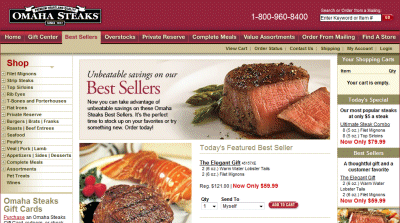Archive for the ‘Food’ Category
omahasteaks.com , Omaha Steaks Coupons
omahasteaks.com $10 off $50 coupon code: AE4458 Ends.12/31
Save up to 62% PLUS 3 FREE Gifts from Omaha Steaks. Exp. limited
Omaha Steaks HALF Price Labour Day Sale going on NOW at Omaha Steaks! Exp. 9/2/2008
Omaha Steaks Save up to 55% on the Ideal Gift Collection plus 2 FREE Gifts from Omaha Steaks!
Exp. 31-Jan-2008
Omaha Steaks Save up to 55% plus 6 FREE Burgers from Omaha Steaks!
Exp. 31-Jan-2008
$10 off your purchase of $50 or more at A La Zing!
Valid between 27-Feb-2007 – 01-Mar-2012
Save $20 on your purchase of $75 or more at A La Zing!
Valid between 27-Feb-2007 – 01-Mar-2012
Save $35 off your purchase of $100 or more at A La Zing!
Valid between 27-Feb-2007 – 01-Mar-2012
Your special student is heading back to school, and deserves a gift he or she can use. With $25 Restaurant Gift Certificates for only $10, the savings adds up to 60 percent. Restaurant.com Gift Certificates can be used at thousands of restaurants nationwide and at quality online retailers. Give them as a gift and let them pick their restaurant to enjoy!
Clubs of America (greatclubs.com) Coupon Code
Founded in 1994, Clubs of America is the original and largest gift of the month club source.
Top rated Beer of the Month Club, Wine of the Month Club, Flower, Cigars, Fruit, Pizza, Coffee and Chocolate of the month clubs.
Free Cigars Contest
Every month one lucky cigar smoker will win a free box of 25 Boutique Premium Cigars and a Cuban Crafters Guillotine cigar cutter. The winner of the monthly free cigars drawing gets to choose any box of cigars offered on the cubancrafters.com cigars website. When you register as a user of this cigar smoking website, you automatically qualify and your name is entered in the monthly drawing. Register now and be this month’s lucky winner!
|
|
(1 reviews)
love it! Hot enought for great steaks. Did BBQ Beef ribs last night,,no flare ups, easy to control temp. Where has this BBQ been? Would have bought it years ago. Great for our Motorhome.
related: RV ( recreational vehicle ) related Product ,RV ( recreational vehicle )
from :
Vitacost.com
Sunday, August 26, 2007
Parental Stress Can Keep Kids Obese
Helping children slim down may mean helping parents, study finds
(HealthDay News) — Parental stress or bullying by peers can make it even tougher for overweight or obese children to get healthy, a U.S. study finds.
“If a parent is distressed, that seems to impact a child’s symptoms of depression, which then impacts quality of life. It’s the same with peer victimization. It impacts depression, which then impacts quality of life. And it seems to affect not just the emotional aspect of quality of life, but also their health status,” lead author David Janicke, assistant professor of clinical and health psychology in the University of Florida College of Public Health and Health Professions, in Gainesville, said in a prepared statement.
His team surveyed 96 overweight or obese children and their parents.
They found that youngsters whose parents were struggling with stress or depression had more depressive symptoms and a lower overall quality of life. The same was true for children who reported more problems with peers.
“One of the pathways to poor quality of life seems to be childhood depression,” Janicke noted. He said parental support is critical in helping children make healthy lifestyle choices.
Parents struggling with stress or depression may not have the energy to provide emotional support, plan healthy meals, or organize exercise activities for their children, the researchers said. Providing support for distressed parents may be an effective way of helping overweight/obese children, Janicke suggested.
Learning more about the factors that affect the well-being of overweight children could help improve methods of treating these children, he added.
The study was published in the journal Obesity.
from :
This kind of fat was strong indicator of trouble ahead, study found
By Alan Mozes
HealthDay Reporter
(HealthDay News) — Banish the belly, not just the pounds: That’s the heart-healthy advice from a new study that finds that “pot” bellies may be a big indicator of future heart disease.
“What we’re seeing is a quite strong association between the pot-belly, apple shape among a relatively young group of people and the build-up of plaque in the arteries,” said study co-author Dr. James A. de Lemos, an associate professor of medicine and director of the Coronary Care Unit at the University of Texas Southwestern Medical Center at Dallas.
“Ten to 15 years down the road, this can lead to major cardiac problems, such as a heart attack,” he said.
The findings are published in the Aug. 21 issue of the Journal of the American College of Cardiology.
According to the American Heart Association (AHA), more than 870,000 Americans die from heart disease each year, making it the leading killer of both men and women.
Cardiovascular disease has long been associated with obesity, and approximately one-third of American adults are considered clinically obese, the researchers noted.
But are some forms of overweight worse than others? Lemos’ team compared various ways of measuring obesity to detect signs of heart disease in the form of atherosclerosis (“hardening of the arteries”).
They looked specifically at atherosclerosis, a systemic thickening and calcification of artery blood vessel walls due to a build-up of calcium and/or plaque composed of cholesterol and triglyceride fats.
The researchers focused on data collected between 2000 and 2002 on more than 2,700 men and women between the ages of 30 and 65, who were participating in the larger, multi-ethnic Dallas Heart Study.
Blood and urine samples were taken from all the participants following completion of a general health survey. A subsequent clinical exam calculated both weight and body mass index (BMI) — a common obesity measurement based on weight-to-height ratios — as well as waist and hip circumference.
All the men and women then underwent non-invasive imaging tests, including MRI to assess atherosclerosis and/or electron beam computed tomography (EBCT) that specifically looked at arterial calcium deposits in the heart.
Such calcium deposits, Lemos and his colleagues noted, collect years before the onset of chest pains or a heart attack.
Detectable coronary artery calcium was found in just over 20 percent (583) of the men and women tested. Almost 40 percent of those who underwent an MRI (976) were found to have detectable aortic plaque.
After factoring out differences in blood pressure, diabetes, age, smoking, or cholesterol status, body shape was a much better indicator of either calcium or plaque status than either simple weight or BMI numbers.
For both men and women, the bigger the belly in relation to the hips — otherwise called the waist-to-hip ratio (WHR) — the greater the likelihood of arterial calcium in the heart.
After dividing the participants into five groups ranging from those with the smallest to the largest WHRs, the authors specifically observed that those with the largest were almost twice as likely to have coronary calcium as those with the smallest.
Even if your belt buckled somewhere between flat and fat, you weren’t home-free, the researchers said. That’s because even incremental increases in waist-to-hip-ratio translated into small but steady increases in calcium deposits.
Those with the largest waist-to-hip ratios were also three times as likely to have atherosclerotic plaque as those in the smallest waist-to-hip group, the researchers said.
Although higher BMI and waist circumference readings alone were also associated with signs of atherosclerosis, waist-to-hip ratios were found to be much more stronger indicators of either calcium or plaque build-up.
Lemos and his team noted that BMI, in particular, does not gauge body composition, because it fails to account for the fact that abdominal fat — as opposed to fat around the hips — may be much less healthy. Abdominal fat appears to trigger a chain of inflammatory activities that translates into harmful metabolic changes, plaque build-up and, ultimately, heart disease, the researchers said.
“The good news for patients is that it’s not an ‘all or nothing’ situation,” said Lemos. “Even little improvements in your body shape are going to prove beneficial, with the goal being the smallest waist relative to your hips that you can have — without becoming anorexic, obviously.”
“It’s not rocket science,” he added. “It’s the kind of thing you work on by incorporating regular routine exercise into everyday living. Nothing heroic, mind you. Just some exercise. And by developing good eating habits. And most of that revolves around moderation. It’s not about crash diets. It’s about learning portion control. So the best thing we can do is unlearn everything our parents taught us. Meaning, we should definitely not finish everything on our plate.”
Cardiologist Dr. Curtis M. Rimmerman is medical director of the Westlake, Lakewood, and Avon Pointe branches of the Cleveland Clinic in Ohio. He described Lemos’ work as a “start in the right direction” toward refining heart disease screening methods.
“I wouldn’t say this finding is surprising,” Rimmerman noted. “But it is certainly a reasonable assertion to suggest, given limited health care resources, that health care advisors focus on central-weight distribution rather than weight alone as a more precise way to identify at-risk patients in need of aggressive treatment and follow-up. In that sense, this is a valuable step forward.”



